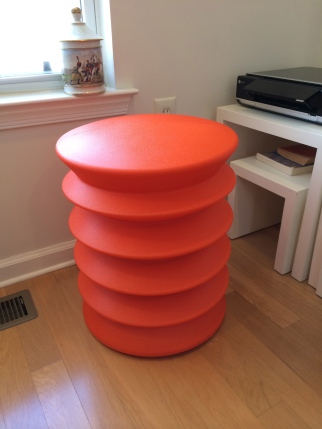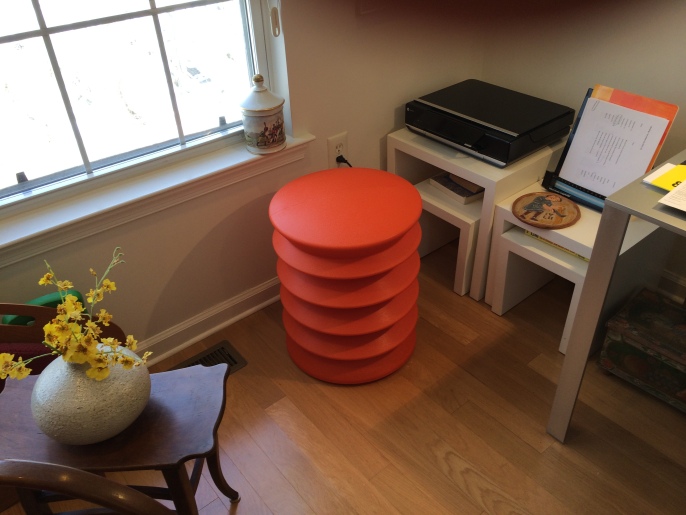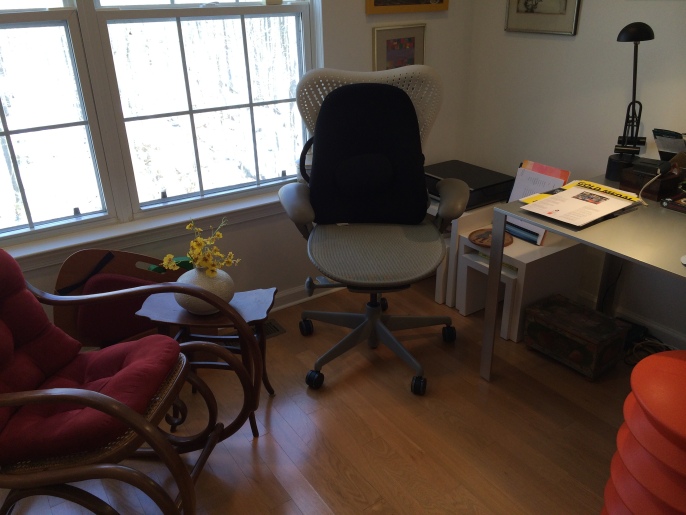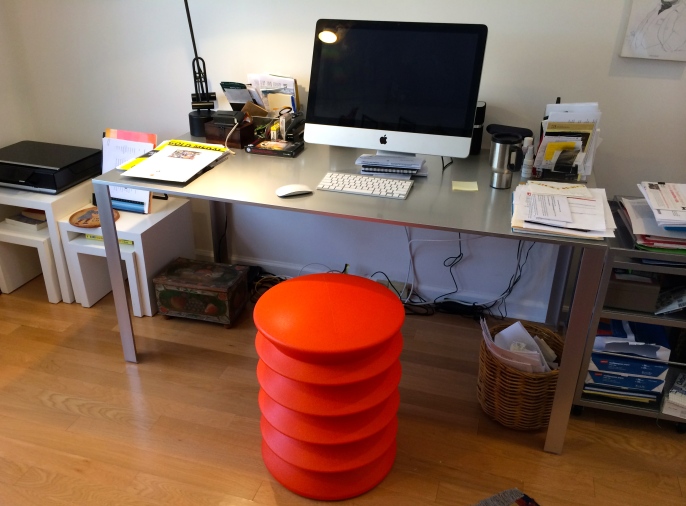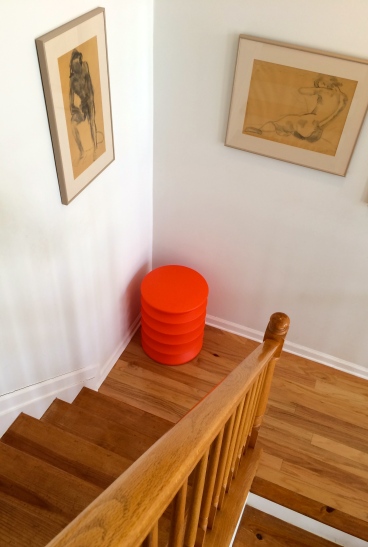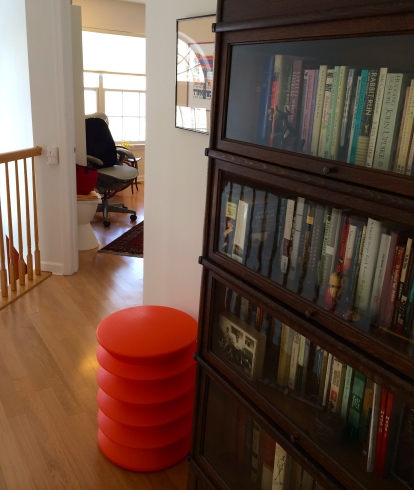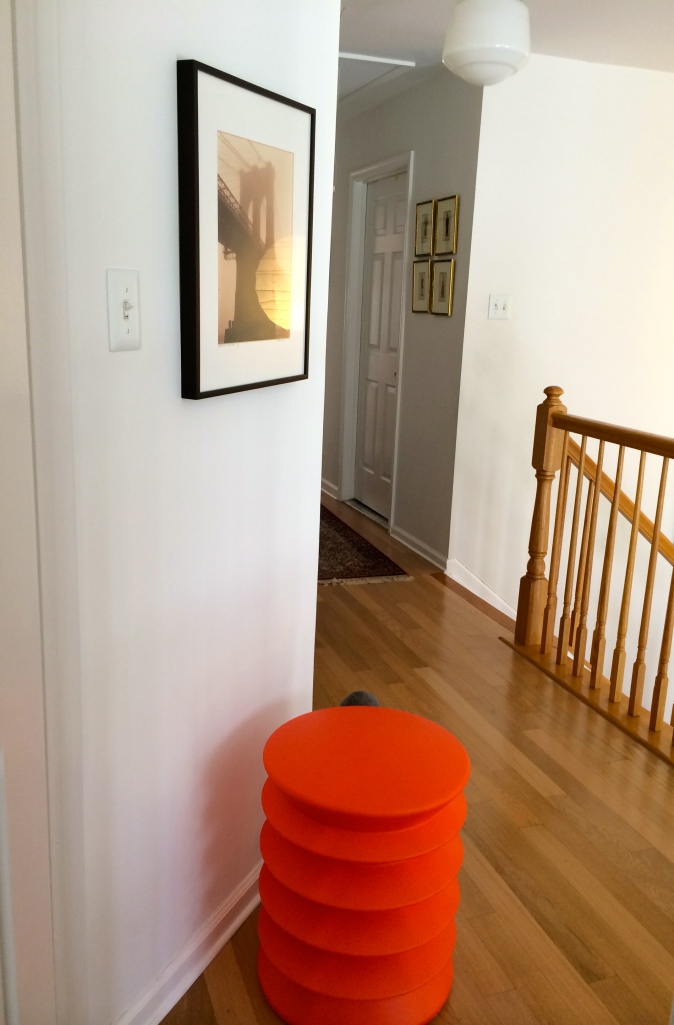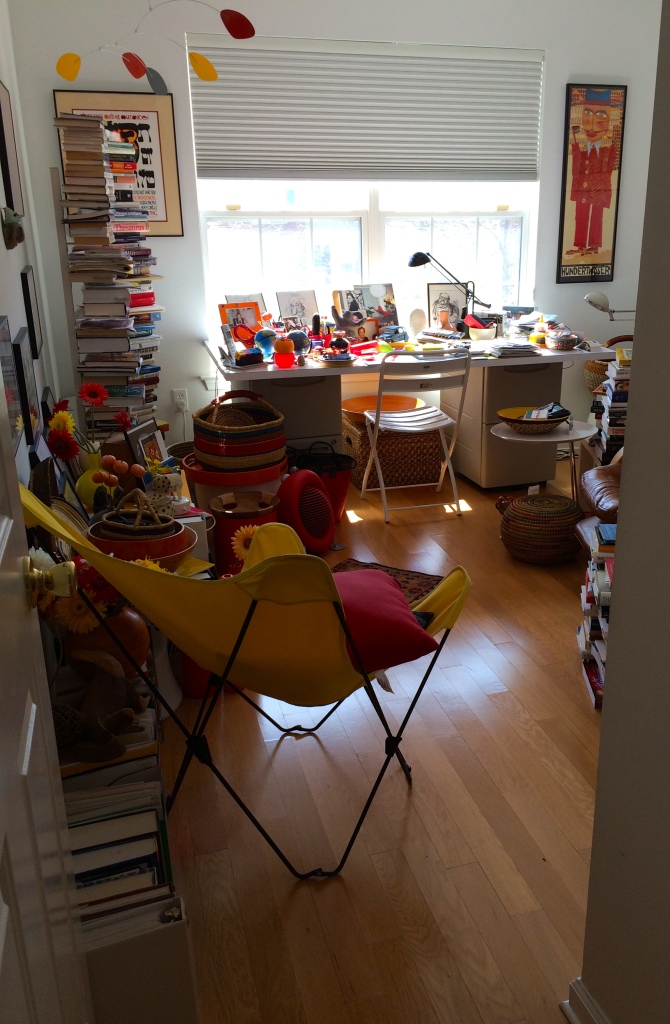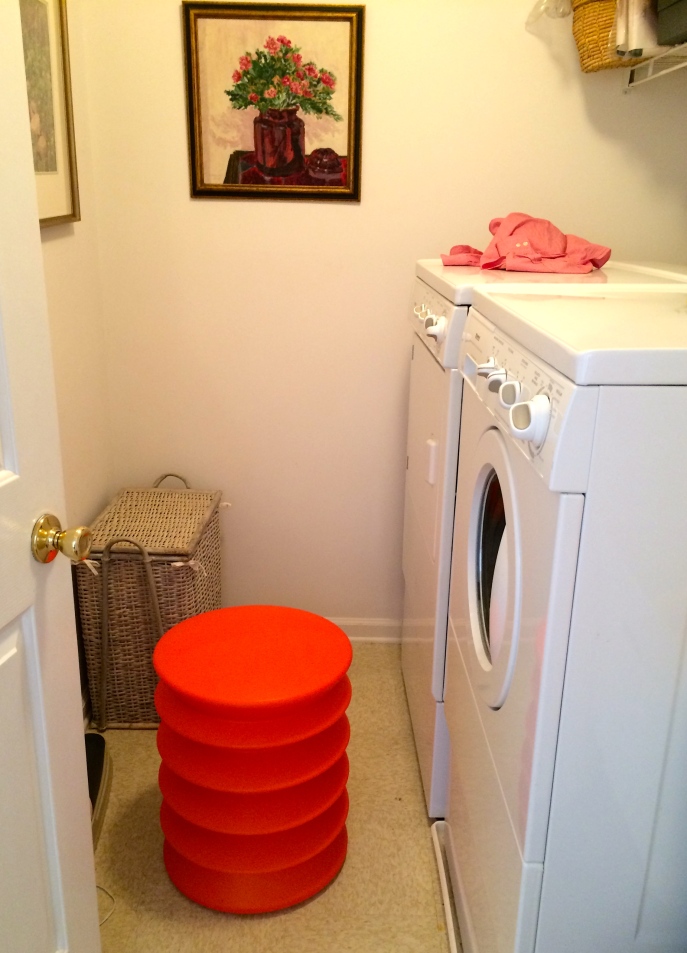[This is the last in a series of four pieces arising from my recent, and in some ways still ongoing, experience with an obscure and distressing skin affliction apparently extremely rare in adults. They haven’t been only about skin, though. Is anything ever really just about what it first appears to be?]
I never thought I would ever be filing a Getting Old Blog post under a caption that would turn me off and on to something else in a blink of an eye if someone else had written it.
I am also entirely aware that no one, including me, wants to be told what to do, and that advice about what to do about your health and general well being is particularly unwelcome. Until you’re plagued with unwellness. For most people, that tends to happen more as you get older. Which may be why the caption above sounds like something you might find in a publication from AARP [American Association of Retired People], all of which go straight into the recyclable paper bin at our house. [They go there because AARP’s advice is always conventional. It’s also nothing Bill and I don’t already either know or don’t find too simplistic.]
So if you’re in what used to be known as “the prime of life,” you should probably move on for now, while you still feel pretty good — knock wood!– and full of pep and vigor. Unless you’re curious. Or tend to take the long view. Or for some other personal reason have begun to ask questions about the effects of a first world market-driven economy on human well being which are not the usual economic, or political, or even environmentally concerned questions.
As for those of you who are no longer young, or youngish, and don’t feel quite as good as you used to, if you ever did feel really good, you may not like what’s coming, either. It’s very hard to swim against the tide, to begin doing things other people aren’t doing, to investigate aspects of health your doctor may not know about or may shrug off, to risk being thought a crank. It’s easier and pleasanter to be like the other guys, go with the flow, enjoy doughnuts (or on a more upscale level, pain au chocolat, foie gras, Sacher torte), and avoid striking out on your own.
No, I don’t think we can live forever if we eat only the right things and use non-toxic personal care and cosmetic products, and if we try to rid our indoor environments of most of the sources of the minuscule amounts of contaminants that slowly build up inside us and force our immune systems into an ongoing battle which they will eventually lose as we, and they, age.
What I do think is that each of us can live somewhat better for somewhat longer. I believe there’s a certain satisfaction in being master of your ship, in having some control over what happens to you — however hard it may seem at first. I believe in fighting the good fight. As the worthy Rabbi Hillel is said to have said: “If I am not for myself, who is for me?”
He is also said to have said: “If am only for myself, what am I?” And then, “If not now, when?” That’s why this last, and possibly distasteful, post of the series. Take what you wish, or don’t wish, from it. I guess the point is that to a considerable degree your well being can be up to you, whatever the odds and whatever age you are.
A. Food and drink.
It’s axiomatic that we are what we eat. But what are we eating? What is “food?” Not everything the Food and Drug Administration says is safe to put in your mouth and swallow, and that can make its way through your digestive system (with more or less difficulty) and out the other end (with more or less difficulty) is “food” in the basic sense of the word, however tasty you may find it. In first world countries, it is much more likely to be an edible non-food substance. Or else what looks like food — but is so impregnated with toxins and (in the case of factory farming) antibiotics as to be worse than useless as nourishment.
I begin with the assumption that “food” — as human beings and all other forms of animal life have consumed it for millennia — is organic material caught, gathered, or grown and then ingested for two purposes: (a) to provide fuel/energy for life to continue at optimum levels — in other words, to provide sufficient, but not overly sufficient, calories; and also (b) to provide all the macronutrients and micronutrients — the vitamins, minerals, amino acids, anti-oxidants, etcetera — that enable every cell of your body to repair itself and function properly, as it was designed to do. These, of course, include not only every cell of your heart, lungs, brain, liver, kidneys, digestive system, bones, joints, skin, blood but also the cells that provide you with immunity from the perils of the biological universe in which we all live.
A great deal of what almost all of us eat today in prosperous first world countries isn’t that, even if we pay more for it under the assumption that more expensive always means “better.” I can only speak specifically of the United States here, but I am going to assume that matters in Canada and Great Britain are similar, and from what I’ve seen of the new supermarkets in France, that that allegedly gastronomically elite country is moving in our direction as well. Except for the very poor, who may not qualify for or avail themselves of food stamps, we all get enough calories — more than enough, if the obesity rates are to be believed.
It’s the other, equally important, element in food as our great-grandparents knew it that is now in danger of vanishing from our food supply. Our advertising and packaging skills are magnificent. Our ability to keep manufactured food from spoiling practically forever is extraordinary. [What is the shelf life of a Twinkie or a Cheez Doodle? And why do you suppose that is?] Our laboratory knowledge of how to enhance taste appeal to the destruction of nutritional value is put to fullest use, so that you will eat more and buy more. We know how to get the most profit out of livestock through factory farming that is both cruel to the animal or bird or fish and detrimental to the health of the consumer. We know how to protect crops from every kind of infestation by saturating the earth they grow in with toxic pesticides that go into the root system and thereby also saturate the developing cells of the very foodstuffs they are designed to “protect,” so that you can’t “wash it off” no matter how hard you scrub. [And how do you scrub a strawberry or a blueberry, anyway?]
These areas of discourse are beyond the scope of any blog post. Let me say only that I have never been, and still am not, a saint here. Until about thirteen years ago, my principal concern with the food I ate was its calorie count coupled with a lingering awareness that one should get enough “vitamins” (available through a supplemental tablet, I thought) and “protein,” which I assumed was available only from animal sources, defined loosely to include eggs, milk products and cheese. As I grew older, however, and felt lousier, I began to read more about what I was eating and what I perhaps should have been eating. Then I met Bill, a vegan at the time. (Now more of a modified and knowledgeable vegetarian with lapses. We’ve changed each other.) So by the time I encountered the virus that just laid me low for over three weeks, I was pretty far along in knowing what was going into my mouth and making reasonably wise choices about it — as far along as I thought I could get without being a self-sufficient organic farmer. And without being entirely ascetic. I already wanted the most nutritional bang for my buck, even if it cost more. And I already wanted the least amount of toxins and chemical additives (with known or unknown harmful qualities) in my food.
These are now my assumptions:
1. I stick with the outside aisles of big modern supermarkets, where the produce, meat, fish, dairy are. I avoid almost all of the middle, a fairyland of processing and packaging.
2. Organic is better than non-organic, because you can’t wash off the toxic pesticides. Yes, it costs more. But then I think of all the money I’m not spending on the stuff I’m now not buying.
3. Less animal-sourced “protein” is better than more, but if I’m going to have it once in a while, I make sure the eggs come from organically pasture-raised chickens and that the beef comes from grass-fed cows (even if it is harder to chew) and is also hormone free.
4. If I must, once in a while, buy something edible that has been processed and packaged, I choose glass containers over cans because almost all can linings made in the United States contain a coating of epoxy resin made from BPA (bisphenol A), which disrupts the endocrine system as well as helping preserve the contents of the can.
I am also aware, in an almost entirely unscientific way, that in general: (a) raw is more healthful than cooked; (b) microwave heat changes the molecular structure of food and thereby presumably destroys all its nutritive value other than its calories; and (c) no-stick pans, however easy to clean, are bad for you because something harmful in the no-stick surface gets into the food you prepare on it. I should also now add awareness that: (d) no matter how carefully I tread through the quagmire of American food production, my aging digestive system will no longer fully benefit from what I ingest and requires careful supplementation from trusted sources. (Not the drugstore.)
Of course, there’s more. There’s always more. So perhaps I hadn’t been quite ascetic enough when I encountered the triumphant virus four weeks ago. I have since begun to monitor what we consume much more carefully. We gave away the microwave two years ago, but since the arrival and eventual departure of the general viral exanthem with which I’ve been contending while I was away from the blog, I’ve also rid the kitchen of the two no-stick pans remaining, and augmented the supplements I take with S-acetyl glutathione, a powerful antioxidant now newly formulated in nutritionally available form.
Given my up-front acknowledgement that nobody really welcomes advice about how to eat from anyone else, I will stop here — but with a reading list. If anyone wants to explore any of the ideas set forth above and is an absolute novice in this kind of thinking about what to feed yourself, I guess that person should begin with Michael Pollan’s “Food Rules: An Eater’s Manual.” It’s short and very easy to read. If Pollan seems too difficult to put in place in your own life, Andrew Weil is a gentler, kinder guide. “8 Weeks to Optimum Health” might be a good one of his books to start with. A more recent book of his is “Healthy Aging: A Lifelong Guide to Your Physical and Spiritual Well-being.” I eventually found him too permissive in certain ways, and his recipes not always to my liking. But I would trust him.
On the subject of protein from animal sources, you might want to check out T. Colin Campbell’s “The China Study” (subtitled, “Startling Implications for Diet, Weight Loss and Long-Term Health”) and Jonathan Safran Foer’s “Eating Animals,” a compelling and extremely well-written book even if you have no concerns whatsoever about the current state of your well being. For hard-core pursuit of health, there’s Joel Fuhrman’s “Eat to Live.” Everything he says seems to me to be right; to try to do everything he says is beyond me. (And we did try, twice!) Fuhrman has subsequently written many other books and “nutritarian” handbooks. I consider them inspirational rather than directive, but well worth reading. It’s also worth incorporating into your life as much of what he has to say about health as you can. Weil and Fuhrman are both M.D.s. So is William Davis, author of “Wheat Belly,” the somewhat excitable style of which I disliked, but whose book seems essentially reliable and deserving of attention, even if you decide not to act on what you discover in it. (He’s not alone in condemning what has happened to wheat in the last 100 years and what eventually happens to you when you eat it regularly; other nutritional authorities have reached the same conclusions.)
If weight is also an issue, you may find “Fat, Sick and Nearly Dead” both amusing and a good kick in the pants to get going and do something about it. It’s an awkwardly made film by an Australian amateur named Joe Cross about his own successful pursuit of a very great weight loss, supervised by Joel Fuhrman, and the even greater successful weight loss of someone he encountered while in in the United States who was inspired by his example to do likewise. I am certain no one reading this blog can possibly be as fat as either of those two men, but it’s encouraging to think that if they can do it, anyone can! Less entertaining but a book I found helpful with weight loss issues even before I embarked on the quest for healthier food thirteen years ago is “The Philosopher’s Diet: How to Lose Weight and Change the World,” by Richard Watson. It may be out of print, but is probably still available in libraries and on the used book market. Watson was a professional philosopher, and his slender book embraces more that “mere” weight loss. I have read it four or five times. It begins with two quotations, not entirely irrelevant to this post and its three predecessors in the series.
War Came.
Bodies lined the roadside.
Their fat sizzled in the sun.
— Lamentation for the Destruction of Ur. Third Millennium B.C.
And:
Diet … Course of life: way of living or thinking …To regulate oneself.
— Oxford English Dictionary
Finally, in case anyone is interested in where reading all this has led me, I suppose I should conclude by saying that my present nutritional guru, to the extent I have one, is Frank Lipman, an M.D. trained in South Africa who has been practicing what he calls integrative and functional medicine in New York at the Eleven Eleven Wellness Center for some time. He has incorporated into his practice of the traditional allopathic medicine taught in Western medical schools many of the insights and practices of other treatment modalities and therapies, including herbal medicine, Eastern medicine, nutritional counseling, biofeedback, meditation, yoga and acupuncture. He has also become the go-to doctor for certain celebrities, which is in a way too bad, but is also how I discovered him, so I shouldn’t complain. [He was recommended in her blog “goop” by Gwyneth Paltrow, owner of what is said to be the cleanest intestinal tract in show business — a blog I used to follow for fun before she became such a brand, and an expensive one, at that.] Celebrities aside, Lipman offers what seems to me sane, balanced nutritional and other counsel to address sub-optimal functioning; he can help with becoming less unwell and on the path to feeling better.
I have never met him, and don’t expect to. He has certainly never heard of me. But if you’re interested, you can find him online where I did: at www.drfranklipman.com [In the interests of full disclosure, I should add that I don’t blindly buy many of the products offered there, but I do buy, and use, a few of them.] Most of the useful stuff is in his Blog, which can be explored at leisure from the website. You can also sign up for his newsletter, which will bring the most recent blog pieces into your email inbox once a week.
Well, that should keep you busy, if you haven’t already gone away and left me until I go back to pieces of memoir and photos of cats. Onward!
B. Personal care products, makeup and cleaning products.
When I was growing up, there was an advertising slogan for something or other used in the home that proclaimed: “Better Living Through Chemistry!” Yes, indeed! It has certainly happened! Our laundry is now whiter and brighter and can smell like a summer breeze. [Haven’t you seen all those smiling ladies in television commercials rapturously embracing what emerges from their washers and dryers after little Tommy has got mud and jam and chocolate syrup all over everything?] Our non-washable clothes come back from the dry-cleaner safe from moth and encased in plastic that keeps them that way. Our dishes sparkle, our windowpanes are absolutely transparent, our homes are dust-and-bacteria-free and gleaming. On a more personal note, our hair shines, but remains manageable, our teeth are whiter than white. Underarm deodorants and antiperspirants prevent our body odors, if any, from offending others — and even deter us from perspiring and ruining our cashmere sweaters! Our faces, if we choose, can be a canvas for a whole palette of treatment and cosmetic products to keep us young looking, and visually competitive, and attractive to the other sex. (Some of these are unbelievably expensive, but others can be acquired at your neighborhood drugstore.) I understand men too have a cornucopia of available shaving and after-shave products from which to choose the perfect solution to whatever problems they seek to eradicate along with their daily stubble. And then there’s hair color, and straightening (aka “relaxing”), and “highlighting.” With regard to these, only the price and the tipping are non-toxic, except perhaps to your credit card.
All this, and more, has come at a price in personal harm which until now I didn’t really think about much. Thanks to such better living through chemistry, plus air-conditioning behind closed windows in summer, which are also closed in winter to keep the heat in — the domestic interiors in which we live are today apparently far more toxic than even an urban outdoors polluted by vehicle and industrial exhaust. We inhale these toxins from our indoor air; we absorb them from our clothes and furniture through our skins; we apply them directly to ourselves in the personal care products we use. And our seemingly indomitable immune systems take them all on, and try to subdue them as best they can, so that we don’t get as sick as we might.
But all these things are “safe,” you may protest, or else they couldn’t be sold! Federal agencies judge safety by the application. The minuscule amount of toxicity in one spritz of Pledge is “safe.” But go on spritzing, and sudsing, and purifying, and deodorizing — and it gradually builds up in you, and builds up, and builds up; after a while the amount you harbor inside of you isn’t quite so minuscule or safe anymore. General malaise, poor digestion, dry and itchy skin, undue fatigue, unexplained aches and pains too minor for medical help but not quite minor enough to ignore? And then something more identifiable, about which a dermatologist or other medical specialist may remark when asked: “It happens.”
In a very few ways, Bill and I had begun to address this huge problem earlier. I have never had wall-to-wall-carpeting because I like wood floors — which is fortunate, because no matter how clean you are, tacked-down wall-to-wall carpet harbors mold and mites and things that are very bad for your lungs. Thanks to Bill, who does have lung issues, we had already installed a large air purifier in the bedroom and another downstairs. We also have a water purifier installed in the kitchen for the water we drink and cook with. But the products with which we, and our cleaning ladies, filled the bathrooms and the under-the-sink kitchen cabinet and the laundry room and the utility closet? We have a big job ahead of us there! Not to mention my personal bathroom clutter of Bobbi Brown and Laura Mercier and Lancome and Chanel cosmetics, makeup removers, plus Crest toothpaste, and the shampoo and conditioners from France promoted and sold by the hairdresser.
It will involve study, elimination, and trial and error. I’ve already replaced the shampoo, got rid of the conditioner, thrown out all aerosol sprays, eliminated any cleaning product or personal care item with “natural fragrance” (unless from an entirely natural source like lemon oil or lavender), chucked the Tide, the Clorox, the fabric softener, the handy laundry “pods” I wrote so happily about in a post a few months back. No more plastic bags in the closet, entrapping the PERC (tetracholorethylene) with which my dry-cleaned clothes were saturated. No more conventional dry-cleaning at all, because PERC is a known neurotoxin. The way to go seems to be either wet-cleaning and air drying, or else dry cleaning with carbon dioxide. There are cleaners who have installed the special equipment required for these two processes. They charge more. There’s one in Princeton, and I am about to find out how the five oldish sweaters I brought them last week for a trial run will look when I pick them up. As for everything else, I am in transition.
The two authoritative sources for how to proceed are the Environmental Working Group (EWG) and its sub-division Skin Deep (for cosmetics and personal care items). If you have the interest and can invest the time, you can find out everything you need to know about safely cleaning yourself, your clothes, your hair and your indoor environment from their websites. The EWG site is http://www.ewg.org The Skin Deep one is http://www/ewg/org/skindeep/ If you have young children, you may also be interested in reading about the effects of toxicity on child development (and on the development of children’s brains and neurological systems) by subscribing to the newsletter of the Children’s Environmental Health Center of Mount Sinai Hospital in New York, which can be obtained on the Center’s website: http://www.cehcenter.org You can go a little crazy, as I have. (But then, I have just been through a crazy-awful time, and if somewhat detoxifying the place where I spend most of my life these days will help prevent its recurrence, or help prevent something equally unpleasant, I am hyper-motivated to try.) Alternatively, you can take it slowly, one piece at a time. Or you can forget the whole thing, and rest assured that this post is almost over.
I will not give up everything in favor of castile soap, white vinegar, baking soda, washing soda, hydrogen peroxide (for disinfecting) and tea tree oil — the six substances apparently sufficient for cleaning, disinfecting and deodorizing everything in one’s home and laundering one’s clothing. I know I will not give up Keratin treatments twice a year at the hairdresser, because really straight hair has changed my life for the better to a degree you would not believe unless you had spent most of your life, as I did, wildly curly-haired in a straight-hair culture. I will not entirely give up my indulgence in several costly French fragrances (in eau de parfum or eau de toilette form), although I may not apply them as frequently as I used to. I will not abandon the light application of cosmetics that enhance my face and the look of my eyes, although I will try to find alternatives to what I am currently using on the Skin Deep website. But I will be moving, product by product, towards less toxic ways of living (irrespective of the loss to the manufacturers of these unnecessary products of my tiny contribution to their financial health). And that’s probably more than enough from me on this subject, although I will be glad to answer any specific question about it raised in the comment section below, to the extent that I can.
Finally, as I step down from the podium, let me add that If this excessively long piece has been in any way helpful, or has made you think about things you take for granted in new ways, then it was worth writing. And if not? Well, I guess we can’t win ’em all. Now that I’ve stopped scratching, I’ll be back to my usual sort of thing next time.


